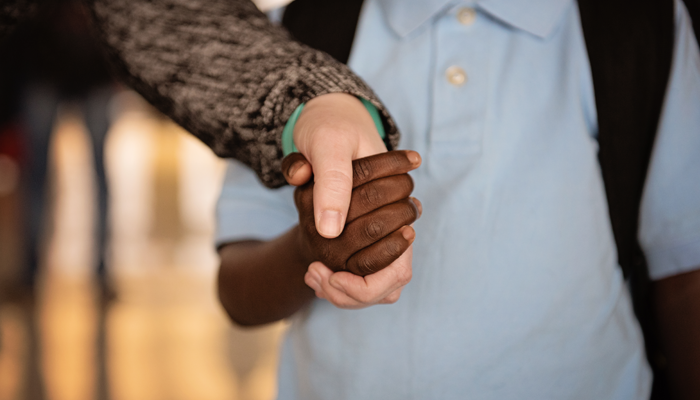Whenever there is a natural disaster and people are forced to evacuate their homes, one thing most take with them are family photos. Going through old pictures and remembering the past is important to everyone.
Some of us adopted our children at birth and are able to document their lives from day one, others are given a small number of treasured photographs from orphanage caretakers or foster families. But some parents adopt older children without a shred of photographic evidence of their lives before they joined their new family.
There is much talk about preparing lifebooks for children who were adopted (especially children who spent time in foster care), so they can make sense of their past, but it is also important for children to have pictures of themselves growing up in their adoptive family.
Ideally, every child would have photos that start from birth, and include their lives before adoption. But, even if such photos don’t exist, you can start documenting your child’s life from the time he or she joins your family. Capturing special moments and making these photographs available for children to look at as the months and years pass establishes a family history and allows for moments of bonding, as you reminisce about shared experiences.
Compositions to Capture
A combination of different types of pictures will help tell the story of your child’s new life.
Milestones: As the parent of a child who spent time in foster or institutional care, you may have missed milestones like her first tooth, first words, first steps, and first day of school, but there are still other firsts to document. Perhaps the first time getting ice cream as a family, the first day at her new school, or your first bike ride together.
Portraits: Pictures that clearly show a child’s face will document how his facial features change over time, and full body portraits show how he is growing.
Candids, with Context: Take pictures of your child engaging in activities she loves doing, and with items that have meaning to her. If you were told about a hobby or activity she loved to do while in foster care, document her doing these things now.
Family Shots: Most important, take pictures of your child with family members. Make sure there are images of the entire family, including the person who is usually responsible for taking the picture.
Professional Photos: Splurge for a professional photographer once in a while. Consider a documentary session in which the photographer spends time with your family and photographs you interacting with each other, rather than in formal poses. This is a great way to get pictures of the whole family together, rather than always having one person missing from the images. We often think our day-to-day lives are mundane and not worthy of being documented, but it would be a gift to our children to provide them with pictures of an “ordinary” day in their lives.
Give your Child the Camera: Depending on your child’s age, she may already have her own phone and/or camera, but, if she does not, give her the opportunity to use yours to document her and your family’s life from her unique perspective. You may learn a few things about how she views her world and what is important to her.
Making Photos Accessible
Pictures are important for our children, as they are for us, but they have to be accessible to fulfill their purpose. We live in a digital world, and we simultaneously have too many pictures and not enough. The pictures that live on hard drives and CDs and clouds and memory sticks are, for these purposes, useless. Hard drives fail eventually, technology changes, and even those pictures we post on Facebook and Instagram may be lost one day when those platforms change. It is also hard to control the sheer volume of images we take every day. How many pictures are on your camera roll on your phone? There are 8,026 on mine at this moment. Will I ever sort through those to find the ones with meaning? No, and, most likely, neither will you. There are many ways to make sure everyone in the family has access to their photos.
To make pictures available to our children, they should be printed. Hang family pictures and pictures of favorite moments on the wall or display them in frames so they are always visible. Do this as soon as possible after your child joins your family. This will give both you and him a visual reminder that he is part of this family. Create photo books for each child or compile prints in a box. Maybe your kids are like mine and love sorting their images into their photo binders. This often encourages conversations about the events shown in the pictures.
If you use social media, use companies such as Chatbooks, which turn Instagram posts into a small, printed book. If your children are younger, consider making placemats with pictures of the family together.
Think quality over quantity. It’s possible for a photo book to contain too many images; choose page layouts that feature just a few images. Flipping through too many pages of pictures of the same thing can get tiring and kids (and adults) will lose interest.
If you’re printing important single shots, be sure they’re printed on archival quality paper so they will last a lifetime. Companies such as mpix.com and AdoramaPix offer good quality photos to consumers. Think about these pictures as a legacy you are leaving to your children. You want to make sure they are available to them as they grow up, and when they have kids themselves.
Photography Pointers
What type of camera should I use? Many of us buy new cameras when we become parents. As a photographer, I am often asked which camera I recommend for families. Generally speaking, I do think it is worthwhile to upgrade from a point-and-shoot type of digital camera to a DLSR (digital single-lens reflex). As a parent, chances are, many of your pictures contain fast moving subjects. Thus, I would say it is essential that your camera (and the lens) have a short shutter lag (the time between when you push the button and the camera takes the picture), and are capable of fast shutter speeds. Oftentimes, it is not the actual camera that is limiting the kind of pictures you can take, but the lens. In order to take pictures in low light, or to allow the very fast shutter speed needed to take a photo of someone running or biking, the lens has to be able to let a larger amount of light in. If you are unhappy with the quality of pictures your DSLR is taking, research different lenses.
There are several brand and model options for DLSRs, which can range from several hundred to several thousand dollars in price, and technology changes quickly. So, in terms of a specific camera recommendation, I recommend reading current technical reviews on websites such as Digital Photography Review and Ken Rockwell’s Camera and Lens Reviews. As you make your decision, consider what your needs and wants are. Are you interested in learning a little about photography or do you simply want to have a convenient and uncomplicated way to take pictures of your kids in action?
What camera settings should I use? The camera cannot read our minds. It doesn’t know whether we are taking a picture of a child barreling down a hill on a bicycle or standing still admiring flowers. As a photographer, I manually adjust my camera’s aperture, shutter speed, and ISO, but I assure you that you do not need to learn to do this to get better quality images. If you simply take pictures using the camera’s auto settings, oftentimes, pictures will turn out grainy or blurry. DLSRs (and most film cameras) come with preset functions, however, and, honestly, this is what I recommend for most of us busy parents. Most cameras have presets for taking portraits, landscapes, action shots, and low light situations. Using these presets tells your camera what kind of picture you are trying to take and the camera will use settings that are appropriate for that situation. If you are taking a portrait, using the portrait mode will blur the background. If you are taking a picture of your child playing soccer using the sports mode, the camera will use a higher shutter speed, so you can capture the kids in motion without getting blurry. Using the specific preset for each situation will allow you to take beautiful, high-quality photographs. If you look at one section of your camera’s manual, make that the presets overview.
Do I have to own a “real” camera? No, it is perfectly OK to pass on purchasing a DLSR. Today’s cell phones produce decent quality pictures and most of us carry a phone with us already. Cell phones can also be a wonderful tool for capturing moments in which a regular camera would distract the subject or feel too intrusive. A child who is new to your home, in particular, might be leery of a big camera lens in his face, but not feel intimidated by your using your cell phone.
Most cell phone cameras offer different features or setting that can make big improvements in the quality of the images you capture, such as:
- Image size: Be sure your phone is capturing images at the largest file size.
- Focus: Say your subject is not in the center of the composition, or close to you, and out of focus. Tap it on your screen and this will change the point of focus.
- Light: You can also adjust the light exposure by tapping on the screen. To avoid having the exposure level readjust as you move your phone, tap and hold to lock it to that exposure.
- Burst mode: Try this iPhone and Samsung camera feature to capture action shots. Tap and hold the shutter button and the camera will take 10 photos per second. Select the clearest image to save.
- Portrait mode: The newest iPhone “Plus” models include “portrait mode.” This setting allows you to take photos with the subject’s face in crisp focus while softly blurring the background.
To further improve your cell phone images and correct minor issues, such as over- or underexposure, there are free editing tools for your phone, such as Photoshop Express. And then, don’t forget to make prints!
How should I organize and store photos? Of course, with 8,000+ photos on your phone’s camera roll alone, you’re not going to print every photo you take. Before you think of storing your images, ideally you would cull all images that are duplicates, bad quality, or simply not important. Having fewer images means that it is easier to find the ones that are important, and it makes printing photos a less daunting task.
It’s also important to have a system so you can find the pictures you are looking for later on. When I import my digital images to my computer, I give the image folder and files a custom name. I like to use both the date the picture was taken, as well as a descriptive name (like “20180329_School_Performance”). This makes it easier for me to locate the pictures on my computer when I need to make a print. Think of a system that would help you find your pictures!
Now that we have culled and organized our pictures, it is time to make sure they are stored securely. In addition to printing a good number of photos, I store all of my digital files, just as I would keep film negatives. I save all my digital images on a hard drive and also back them up online. Some online storage ideas are iCloud, Amazon Prime Photos, Google Photos, Dropbox, or Carbonite.
Photographs are a wonderful way of showing our children that their lives matter, and that they are part of a family. They also help us as parents look back and see how far we’ve come. Throughout the years, I encourage you to sit with your children when you spend time together during the summer, over the holidays, and other times of year and look at old and recent photos, reminiscing about the day you met, his changing interests and activities, growth, and other memories that reinforce your shared past as a family



